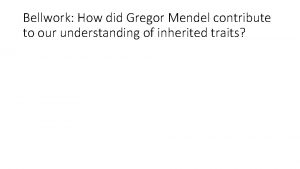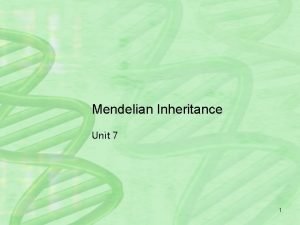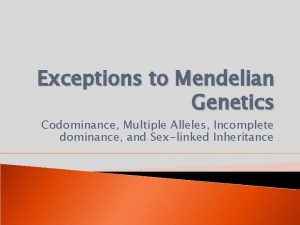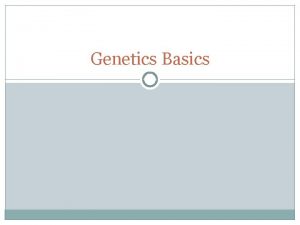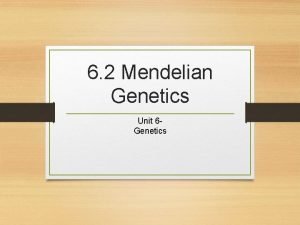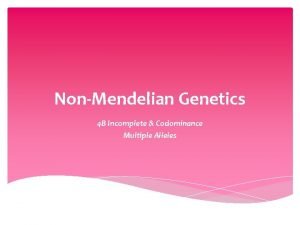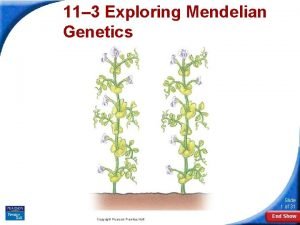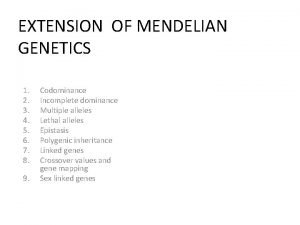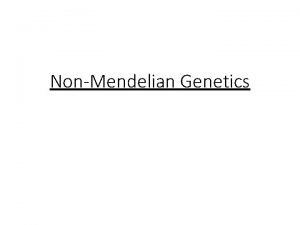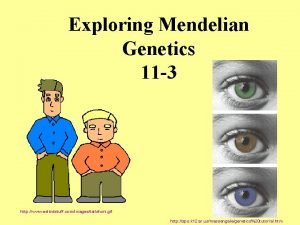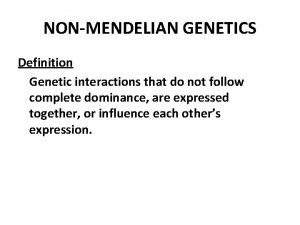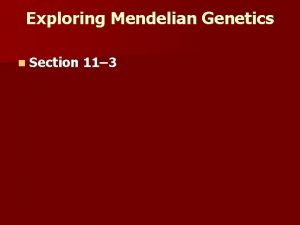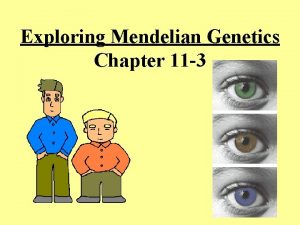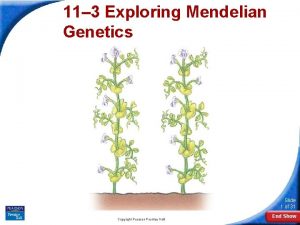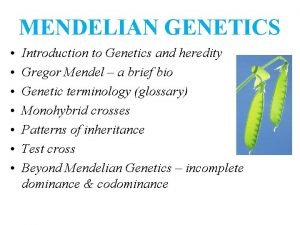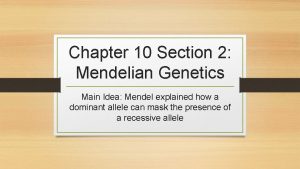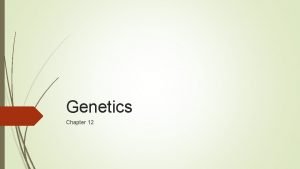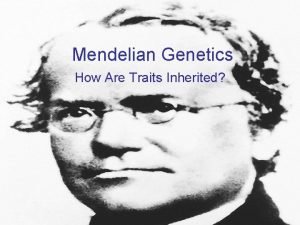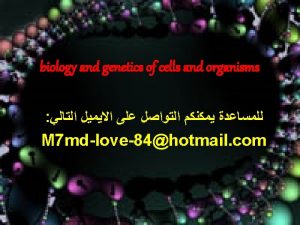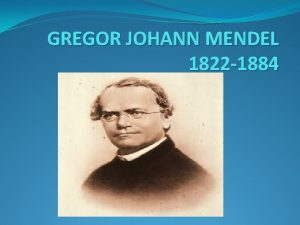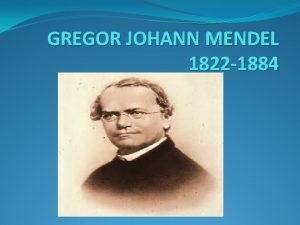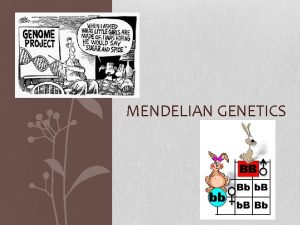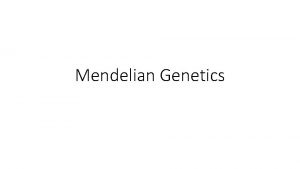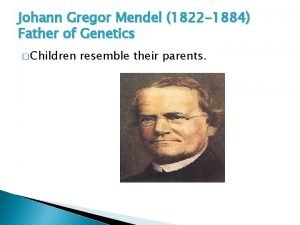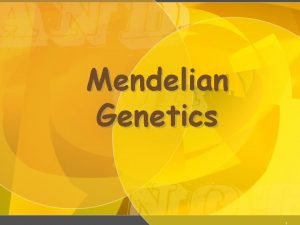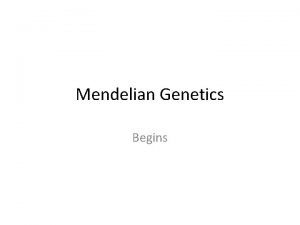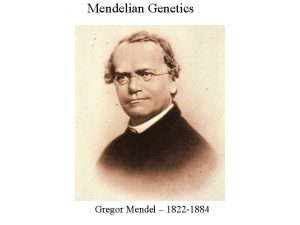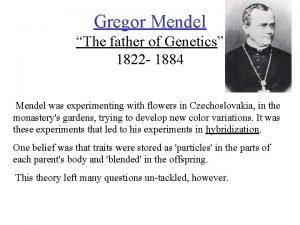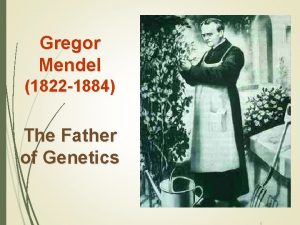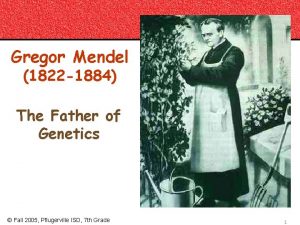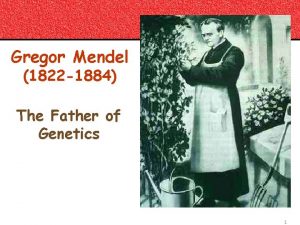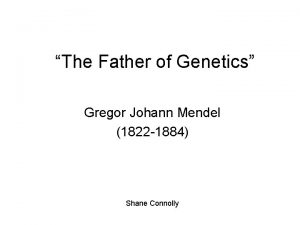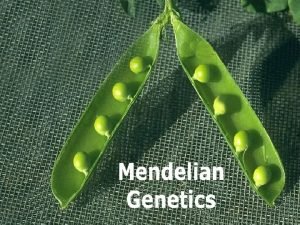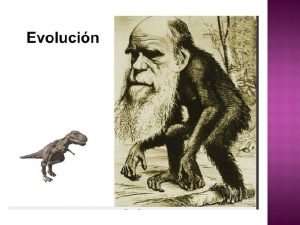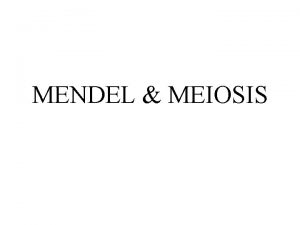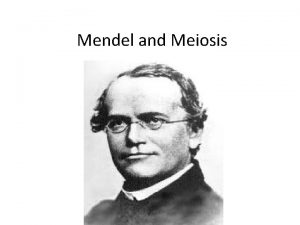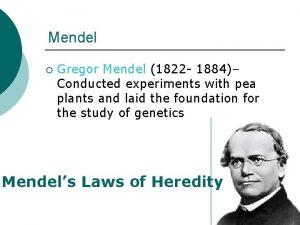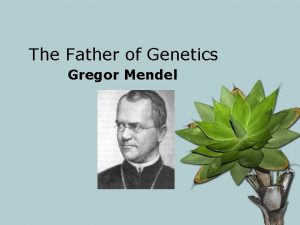Mendelian Genetics Gregor Johann Mendel 1822 1884 father
































- Slides: 32

Mendelian Genetics Gregor Johann Mendel (1822 -1884) “father of genetics”

Many people believed that parents’ traits were “blended” in their offspring. . . A short mother Would produce a child of average height A tall father

Mendel, an Austrian monk, disproved this theory of “blended” traits by studying traits in pea plants.

Mendel chose the pea plant for 3 reasons. . . 1. Structure of the flowers (to control fertilization) 2. Presence of 7 distinct traits (see Figure 6. 5, p. 133) 3. Rapid reproduction cycle of about 90 days

Mendel studied more than 20, 000 pea plants for more than 8 years.

Mendel observed 3 generations of pea plants: P = Parental F 1 = First Filial F 2 = Second Filial

Instead, only the dominant trait appeared in the F 1 generation, while the recessive trait remained hidden In the F 2 generation, the recessive trait reappeared. Mendel proved that traits do not “blend. ”

Mendel concluded that a pea plant must carry a pair of “factors” for every trait.

We now know these “factors” as genes. Genes = sections of a chromosome that code for a trait

Allele = a distinct form of a gene ex: one allele might code for red hair, another for brown hair.

Heredity X Each offspring has two alleles for each gene, one from each parent.

Dominant allele = form expressed when 2 different alleles are present. ex: the F 1 generation to the left has alleles for green and yellow, but only yellow is expressed. Yellow (Y) is dominant in this case.

Recessive allele = expressed when paired with a dominant gene. ex: the green (y) allele is present in the F 1 generation but it is recessive because it is not expressed.

Remember, in SEXUAL reproduction… …to form a …which grows into a HAPLOID gametes DIPLOID join…fetus zygote

Sexual Reproduction Haploid sperm (gamete) 1 n Haploid egg (gamete) + 1 n Diploid zygote = 2 n

s t i r e h n i e t o g y z e h t , e r o f s e t r n e e r Th a p m o r f s t i a tr Heredity is the passing of traits or characteristics from parents to offspring

Genotype = actual genetic makeup of an organism (genes) Phenotype = outward expression of trait (photo)

Genotype Purebred for dominant yellow YY Phenotype YY = yellow

Genotype Hybrid for dominant yellow and recessive green Yy Phenotype Yy = yellow

Genotype Purebred for recessive green yy Phenotype yy = green

Homozygous = the two alleles in a pair are identical; ex: YY and yy Purebred puppies are homozygous for quite a few traits.

Heterozygous = the two alleles in a pair are different; ex: Yy A hybrid mutt is heterozygous for quite a few traits.

Mendel’s Laws 1. Law of Segregation 2. Law of Independent Assortment 3. Law of Dominance

Mendel’s Laws 1. Law of Segregation: each pair of genes segregate during meiosis 2. (organisms can only give half of their genes to their

Mendel’s Laws 2. Law of Independent Assortment: gene pairs segregate into gametes randomly and independently of each other. 3. (most traits are not linked, do not have to be passed together)

Law of Independent Assortment X

Law of Independent Assortment We now know that some genes are linked, therefore always passed together

Mendel’s Laws 3. Law of Dominance: the dominant allele is expressed and the recessive allele can be hidden

Try your hand at breeding pea plants… Click on the website below: http: //www. sonic. net/~nbs/projects/anthro 201/exper/

s r a e Y r… e t la

In 1903, Walter Sutton developed the Chromosome Theory of Heredity. . .

Chromosome Theory of Heredity 1. Chromosomes occur in pairs 2. Chromosomes separate during meiosis 3. Chromosome pairs sort independently
 Pp x pp
Pp x pp Sebastian bach geboren
Sebastian bach geboren Gregor johann mendel
Gregor johann mendel How did gregor mendel contribute to genetics
How did gregor mendel contribute to genetics Gregor mendel’s principles of genetics apply to
Gregor mendel’s principles of genetics apply to Difference between mendelian and non mendelian inheritance
Difference between mendelian and non mendelian inheritance Mendelian genetics vocab
Mendelian genetics vocab Hors xnxn
Hors xnxn Heterozygous blood type a
Heterozygous blood type a Mendelian genetics vocabulary
Mendelian genetics vocabulary Mendels three laws of inheritance
Mendels three laws of inheritance Mendel was a
Mendel was a Extending mendelian genetics answer key
Extending mendelian genetics answer key What does incomplete dominance mean
What does incomplete dominance mean Chapter 7 vocabulary practice extending mendelian genetics
Chapter 7 vocabulary practice extending mendelian genetics Extending mendelian genetics chapter 7
Extending mendelian genetics chapter 7 Chapter 10 sexual reproduction and genetics
Chapter 10 sexual reproduction and genetics Section 11-3 exploring mendelian genetics answers
Section 11-3 exploring mendelian genetics answers Extension of mendelian genetics
Extension of mendelian genetics Is baldness a sex linked trait
Is baldness a sex linked trait Carrier female genotype
Carrier female genotype Exploring mendelian genetics
Exploring mendelian genetics Define pleiotropic gene
Define pleiotropic gene Section 11-3 exploring mendelian genetics
Section 11-3 exploring mendelian genetics What are mendelian traits
What are mendelian traits Section 11-3 exploring mendelian genetics
Section 11-3 exploring mendelian genetics 11-3 exploring mendelian genetics answers
11-3 exploring mendelian genetics answers Section 11-4 meiosis answer key
Section 11-4 meiosis answer key Heredity concept map
Heredity concept map Co dominance
Co dominance Chapter 10 section 2 mendelian genetics answer key
Chapter 10 section 2 mendelian genetics answer key The work of gregor mendel lesson 1 chapter 12
The work of gregor mendel lesson 1 chapter 12 Gregor mendel laws
Gregor mendel laws



